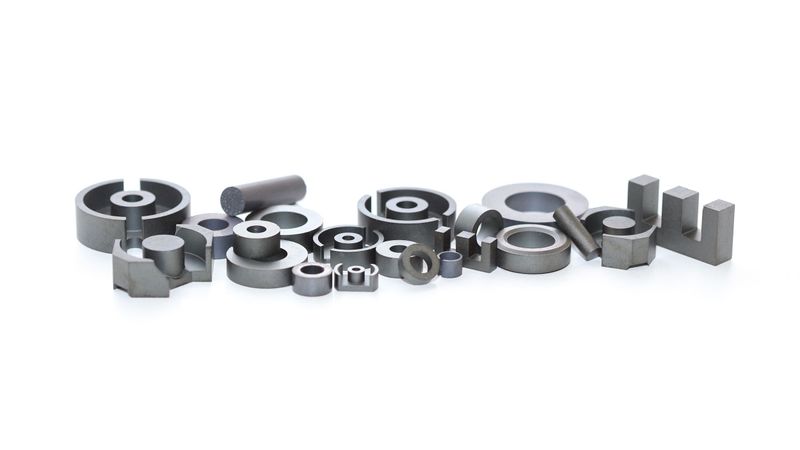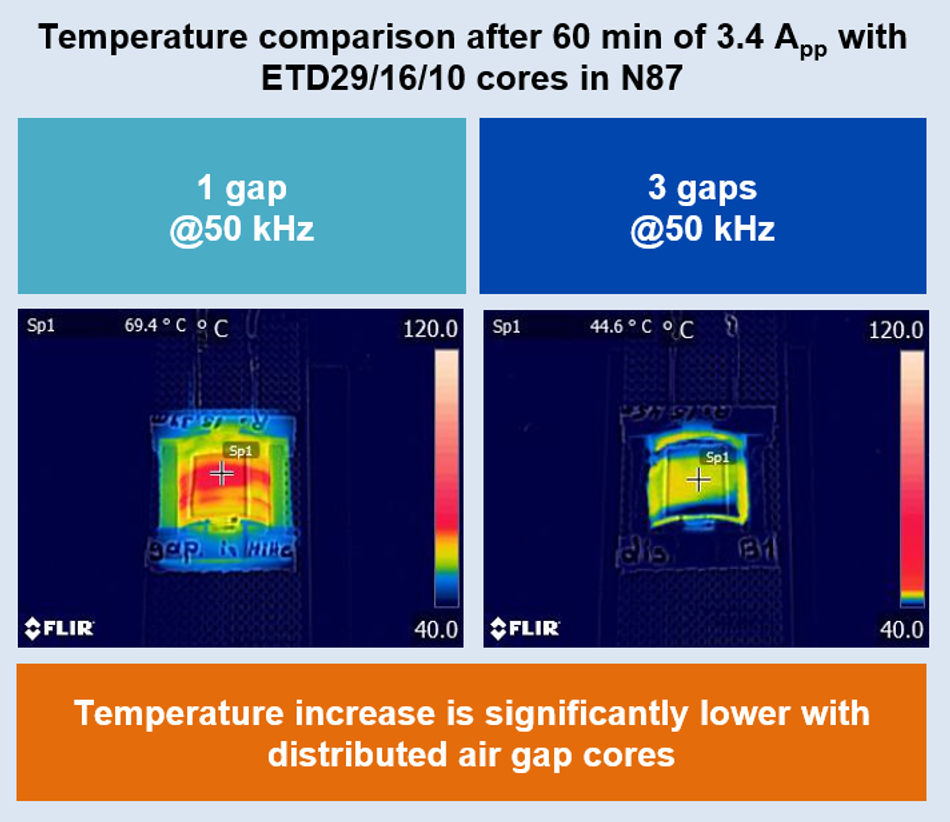Distributed Air Gap Cores: Standardizing High-Performance Magnetic Solutions
Distributed air gap cores, traditionally expensive, enhance efficiency and thermal management in high-power, high-frequency applications by reducing reluctance and fringing flux. Standardization efforts by brands like TDK are making these advanced solutions more accessible and cost-effective.

Magnetic cores are essential in modern electronics, influencing the functionality and efficiency of devices, from power supplies to renewable energy systems. Traditional designs, especially those with a single large air gap, struggle to meet the high-frequency and efficiency demands of present-day applications.
This challenge has catalyzed the development of distributed air gap cores, which are primarily used to increase power handling capabilities, enable higher currents, and enhance the efficiency and thermal performance of magnetics. Historically, the technology behind distributed air gap cores has been around for nearly 30 years but has always been an expensive, highly customized solution –that is, until now.
Today, TDK Corporation, a global leader in electronic components, is innovating the standardization of Distributed air gap cores in a way that is revolutionizing how the market will specify, purchase, and adopt these crucial components. This article explores how distributed air gap cores are revolutionizing magnetic core design, offering a glimpse into their principles, advantages, and standardization efforts led by TDK.
Challenges of Traditional Single Large Air Gap Cores
Traditional magnetic cores with single large air gaps exhibit a number of drawbacks due to their high magnetic reluctance. This reluctance acts as resistance to magnetization, leading to considerable energy losses as magnetic fields stray from their intended paths. The large fringing flux emitted from these air gaps spreads into the winding area, causing copper losses that further lead to a rise in temperature and proximity losses in high-frequency magnetics.
These compounded inefficiencies escalate into several challenges, notably excessive heat that degrades component performance and shortens device lifespan—critical issues in high-power and high-frequency applications. Additionally, the need to mitigate these effects results in larger, heavier cores, posing significant limitations in applications requiring compactness and device miniaturization.
Development of Distributed Air Gap Cores
Distributed air gap cores are a type of magnetic core, which feature a magnetic material interspersed with non-magnetic gaps. These gaps are distributed uniformly throughout the material, rather than being concentrated in one area. By integrating multiple smaller air gaps throughout the core, distributed air gap technology optimizes the magnetic flux path, significantly reducing areas prone to flux leakage and fringing effects. This strategic distribution of air gaps minimizes non-functional magnetic fields and enhances the core's overall efficiency and performance.
Additionally, this configuration allows for a more compact core design without sacrificing power handling capabilities, thus supporting the trend towards miniaturization in technology. The benefit extends to improved thermal management, as the reduced energy losses lead to less heat generation, allowing devices to operate at higher frequencies without compromising their longevity or performance.
Here is a summary of the key benefits of using distributed air gap cores to address issues posed by their traditional counterparts:
Improved Fringing Flux: Anywhere a gap is present, fringing flux is emitted. When there is a larger gap, there is also a larger fringing flux path. By incorporating a distributed air gap, the fringing flux losses decrease as the number of smaller air gaps increases. This can reduce the fringing flux losses by up to 70%.
Increased Power Density and Optimized Efficiency: Distributed air gaps increase the power handling capability of the design. In many cases the winding area is reduced to avoid fringing flux losses. By using distributed gapped cores to minimize the fringing flux, the full winding area can be used. This can allow for either a smaller component or higher power through the originally selected component.
Enhanced Performance: In high-frequency applications, the skin effect and proximity effect can lead to significant losses in electrical conductors. The skin effect refers to the tendency of alternating current (AC) to distribute itself within a conductor such that the current density is highest near the surface, effectively reducing the cross-sectional area available for current flow. The proximity effect, on the other hand, occurs when alternating magnetic fields from neighboring conductors cause the current to concentrate in certain regions of a conductor, increasing resistance and associated losses.
Litz wire is a specialized type of wire designed to mitigate these effects. It consists of multiple thin, insulated strands woven together in a specific pattern, which helps reduce the losses caused by the skin and proximity effects. However, when using distributed air gap cores, which reduce the effects of fringing flux, it is possible to use solid wire instead of Litz wire. This substitution could lead to higher copper utilization within the winding area, thereby increasing efficiency and reducing costs.Utilization of New Semiconductor Material: Distributed air gap cores are well-suited for applications using higher frequency switching technologies like Silicon Carbide and Gallium Nitrides. Their design reduces energy losses and enhances thermal management, making them ideal for handling the increased power densities and rapid switching speeds these technologies require.
 Hot spot comparison for single large air gap vs. distributed air gap cores: distributed air gaps reduce fringing flux and hotspots, improving thermal performance and efficiency
Hot spot comparison for single large air gap vs. distributed air gap cores: distributed air gaps reduce fringing flux and hotspots, improving thermal performance and efficiency
Distributed air gap cores have seen significant innovation in recent years. However, these solutions have been tailored and delivered specifically for the design of each end application.
An unfortunate side effect of this is that each time a core is created for a custom application, it likely will not be used again for another design, increasing the overall cost of the technology and preventing new innovations from being passed on to others.
Introducing TDK’s Standardized Solutions
TDK has responded to the need for taking a highly customized technology like the distributed air gap core and providing a more standardized solution for it. A standardized distributed air gap core portfolio offer reduces the dependence on custom-built offerings and will revolutionize the Distributed air gap core industry. Such standardized solutions will speed up time to market, improve the return on investment, and stimulate innovation while still allowing for application-specific customization.
TDK solutions also offer one of the best total costs of ownership and cost/performance ratios due to reliability and reduced proximity losses. This becomes apparent when a single large air gap core is compared to various configurations of distributed air gaps.
In fact, the best cost/performance ratio is achieved with three identical air gaps. Thermal image test comparisons between a single large air gap, when contrasted against three identical distributed air gap core sets, clearly show significantly lower outputs at varied frequencies.
The TDK Standardization Revolution
As a pioneer in magnetics, TDK is the first to offer standard distributed air gap core solutions. TDK continues to invest in the future of magnetics and to support this introduction. The company has invested heavily in new automated manufacturing processes and equipment that improve the quality of air-gapped core products. 
TDK is revolutionizing how the market will specify, purchase, and adopt distributed air gapped cores with new standardized products. TDK offers the market easy access to a once highly customized solution. Manufacturing innovation is allowing the industry to take advantage of the technology in new ways. Additional innovation will follow, just as it does whenever a custom solution is standardized.
Visit the TDK Corporation’s official website to learn more about their innovative distributed air gap cores and how they can enhance the efficiency and performance of your high-power high-frequency applications.
Conclusion
The development and standardization of distributed air gap cores mark a major advancement in magnetic materials used in electrical/electronics applications. By addressing the challenges with traditional designs, distributed air gap cores enhance efficiency, thermal management, and power handling.
TDK’s leadership in standardizing these cores has reduced costs and accelerated innovation across various industries. As applications in industries, renewable energy, automotive, and high-frequency electronics grow, the importance of distributed air gap cores will continue to rise.
References
[1] TDK Electronics. Distributed air gaps in ferrite cores. Available from: https://www.tdk-electronics.tdk.com/en/180386/tech-library/publications/ferrites/ferrites-air-gaps-standard/2905788
